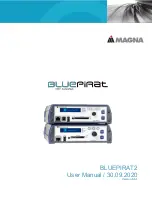
Registers, Data Formats, & Queries
Appendix D
D-6
NetScan User’s Manual
Data Output Formats
Data Output formats differ slightly from data input formats in that binary formats may be used for Channel Data.
Channel Data is the only output data which may use the binary format (if it is specified). Channel Data is
defined as data originating from the High/Low/Last (HLL) Registers or the Acquisition Buffer. The commands
that initiate Channel Data output are the
R
,
R#
,
U4
,
U5
and
U13
commands. However, Channel Data may
also be output as Engineering Units and Counts.
As in the case of Data Input Formats, all other types of output will be in Engineering Units unless Counts is
specified. However, there are only 3 command queries which need to follow the
F
command format in this
fashion. They are
C?
,
L?
and
U8
command queries.
Note:
If Counts or Binary format is specified as the format, the Engineering Units parameter of the F
command is ignored.
Examples:
PRINT#1,"F0,0X"
‘ Output C?, L?,U8 as well as R,R#,U4,U5 and U13 in ‘ Engineering Units
— Degrees C
PRINT#1,"F1,1X"
‘ Output R,R#,U4,U5 and U13 as binary
‘ Output C?,L? and U8 as Engineering Units —
‘ Degrees F.
PRINT#1,"F3,3X" ‘ Output C?, L?,U8 as well as R,R#,U4,U5 and U13 in Counts (Note that
Engineering Units parameter is ignored)
All commands and data sent to the NetScan are in ASCII (although the engineering unit may vary).
Note:
Only data supplied by the NetScan, such as time/date stamps for High/Low/Last registers, can
be in binary format.
Both the ehternet and RS-232 interfaces support data retrieval in ASCII and, for high speed applications, in
binary format. End of Reading and End of Scan terminators are not used with binary data transfers.
Engineering Units Data Format
If the engineering units data format is selected, the NetScan will supply data in format appropriate for the
configured channel type. The selected unit affects the number of decimal places used by either the ASCII or
binary formats . This section describes engineering units in relation to thermocouples, volts, time/date stamps,
and scan intervals.
Thermocouples
The NetScan uses a default system unit of degrees Centigrade. Therefore, the resolution of returned data,
independent of configured temperature units, is 0.1°C. The binary format also returns data in degrees
Centigrade. The default binary format returns two bytes of 2’s complement binary data with user selecting
low/high byte or high/low byte.
If the ASCII data format is selected, the controller can select temperature units. This requires the conversion of
degrees Centigrade to configured temperature unit. Conversion to degrees Fahrenheit, degrees Rankine, and
degrees Kelvin are via the following formulas:
Centigrade:
-3276.7 < C < +3276.7
Fahrenheit :
F = (9/5)C + 32
Rankine:
R = (9/5)C + 491.69 Note: R = F + 459.69
Kelvin :
K = C + 273.16
For channels configured as thermocouples, all ASCII readings will be returned in the format which corresponds
with the engineering unit selected. The formats are as follows, where X is an ASCII digit.
Centigrade :
XXXX.XX
Fahrenheit :
XXXX.XX
Rankine :
XXXX.XX
Kelvin :
XXXX.XX
Summary of Contents for OMB-NETSCAN 1500
Page 6: ...iv NetScan User s Manual...
Page 18: ...1 12 Configuring and Starting NetScan NetScan User s Manual Notes...
Page 38: ...3 8 General Information and Specifications NetScan User s Manual Notes...
Page 82: ...4 44 ChartView Software Reference NetScan User s Manual Notes...
Page 118: ...6 20 Calibration NetScan User s Manual...
Page 140: ...A ii NetScan User s Manual...
Page 192: ...API Command Reference Appendix A A 52 NetScan User s Manual Notes...
Page 237: ...Appendix D Registers Data Formats Queries NetScan User s Manual D 13...
Page 244: ...NetScan Program Examples Appendix E E 2 NetScan User s Manual...
Page 248: ...ASCII Code Summary Appendix F F 4 NetScan User s Manual Notes...
Page 250: ...NetScan Error Messages Appendix G G 2 NetScan User s Manual Notes...
Page 252: ...Abbreviations Appendix H H 2 NetScan User s Manual Notes...
Page 254: ...NetScan User s Manual...
















































